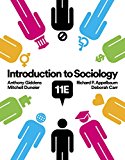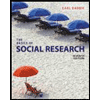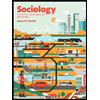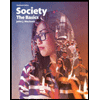ZavalaE1
pdf
keyboard_arrow_up
School
San Jacinto Community College *
*We aren’t endorsed by this school
Course
4322
Subject
Sociology
Date
Apr 3, 2024
Type
Pages
9
Uploaded by LisaAnn1
1 Name:
Exam 1- The Big Three Theories of Society
Prof. Stephen M. Cherry
Directions
: 1) Type an answer for all questions. No need to change fonts, color or highlight etc. 2) Save the Word.doc
with your last name
and E1
as the file name (ex. CherryE1.docx). 3) Send it back to me via email as an attached Word.doc on the due date
. Exam 1 Due W 2/21 1pm… Late exams will not be accepted
. This is an open source exam. Students should be able to submit it before the deadline with no problems. I will reply “Got it” when I receive it. If you do not get a reply within 24 hours, I did not get it; send it again to
cherry@uhcl.edu AND scherry@flash.net
. If it goes to spam, I will eventually be able to retrieve it but send again just in case. Short Answer (2pts each):
1) According to Ferdinand Toennies, what is the difference between Gemeinschaft and Gesellschaft (describe)? The main difference is the relationships. Gemeinschaft is about close, personal connections like those in a family, while Gesellschaft involves more formal, goal-oriented interactions typical of modern society. 2) The key to sociology for Weber was understanding action and the thought processes and meanings leading to said action. What is the German term/word Weber used to describe this? Verstehen is the German term Weber used to describe why people do what they do by looking at things from their point of view. It's like putting yourself in someone else's shoes to get why they think and act a certain way, considering their personal experiences, beliefs, and emotions. 3) Weber suggested that in the future capitalism would lose its spirit and would succumb to increasing rationality and force society into a bureaucratic trap. What did call this? Weber predicted that society would become more and more organized and run by strict rules and regulations, leading to a situation where people feel trapped in a system that values efficiency and order over individual freedom and creativity. He called this situation an "iron cage." It's like saying society would become like a machine, where everyone must follow the rules closely, and there's not much room to be different or creative. 4) According to Marx, all value comes from labor. What did he call the basic value of a commodity before it goes to market? The use-value of a commodity is determined by its ability to meet people's needs or desires. This usefulness comes from the labor and materials that go into making it. 5) Looking at question four, what did Marx call the value a commodity sells for on the market? Marx called the value a commodity sells for on the market its "exchange value." This is how much a commodity can be traded for in the market. Think of it as the "price" you can swap it for other commodities or money.
2 6) What did Durkheim call the breakdown of solidarity characterized by a sense of loss and confusion where an individual or group does not know their place in society and is unable to find resolution through the institutions that have given them direction and meaning in the past? Organic solidarity happens in advanced, industrial societies where people do different, specialized jobs and depend on each other because of these different roles. This shift from mechanical to organic solidarity changes how people connect and unite, helping the economy and technology to grow. However, it can also make people feel lost or disconnected due to the old rules and ways of doing things don’t fit well with the new ways of organizing society to help people feel more connected and meaningful, reducing feelings of being lost or disconnected. 7) Spencer compared social institutions to what? Spencer thought of society as a living body. He said that just like how different organs in a body work together to keep the body healthy and working right, different parts of society (like schools, families, businesses, and government) also work together to keep society running smoothly. Each part has its own job to do, but all the parts need each other to make sure everything goes well. 8) What did Marx call the state of social relations based on exchange based on the belief that a commodity has real value? Marx called the state of social relations based on the belief that a commodity has real value as "commodity fetishism." This idea is about how people think the value of things they buy and sell (like toys, clothes, or phones) comes from the things themselves, rather than from the labor and social relations involved in their production. 9) According to Durkheim, despite its obvious social costs, crime is what? Durkheim said crime is a normal part of all societies and it's an inevitable and normal aspect of social life. He sees crime as functional for society because crime helps show people what behaviors are not acceptable, brings people together against wrongdoers, and even helps society change for the better by questioning old rules and creating new ones. 10) Durkheim considered the study of society as the study of what (what data is studied)? Durkheim thought studying society means looking at "social facts," which are rules, traditions, and social forces that shape actions, thoughts, and emotions. These aren't about individual choices but more about how everyone behaves, thinks, and feelings that operate independently of any single person. Things like laws, languages, and moral rules are examples because they guide how we act without needing us to choose to follow them. They have a strong influence, making us stick to what society expects. If we don't, we might face negative reactions or punishments. This shows how social facts keep society orderly by getting people to naturally follow common norms and values, often without them noticing. 11) Marx and Engels referred to the "ruling class" as the what? They referred to the "ruling class" as the "bourgeoisie." This class owns and controls the means of production and exploits the working class, also known as the proletariat. 12) For Max Weber, there is no clearer expression of modern rationality than what?
3 Disenchantment describes how modern life has moved away from magic and religion and now focuses more on rational, scientific, and bureaucratic approach. This change has made traditional beliefs less important, leading to a life that's more about logic and following procedures. This shift is linked to how businesses grow, the rise of science, and the start of organizations that run on strict rules, all aiming for efficiency and control. Weber saw bureaucracy as the most efficient and rational way in which human activity can be organized. With lots of rules and a clear order, he thought these big organizations were good at ensuring things ran smoothly and predictably. 13) According to Durkheim, the increase of people in a given area led to an increase in their social interaction; he labeled this phenomenon as what? Durkheim describes how more people in an area leads to more social interaction, a concept he calls "dynamic density." He explains two ways society sticks together: through shared similarities (mechanical solidarity) or through different people depending on each other (organic solidarity). As societies grow, they shift from similarity-based bonds to dependency-based bonds. Pluralism is about appreciating everyone's differences in a society, seeing diversity as something that makes the community stronger and helps people get along while still being themselves. 14) What is the theoretical approach in sociology that assumes society is a complex system whose parts work together to promote solidarity and stability? Structural Functionalism sees society like a big team, where every part (like schools, laws, and traditions) works together to keep things running smoothly and everyone getting along. It has a macro-orientation, focusing on the larger social system and its parts, rather than on individual actions or interactions. This perspective is all about how different parts of society fit together to meet people's needs and keep society going. 15) According to Marx, what is the only variable that must be exploited if capitalism is to seek continuous profits? Marx believed that for capitalism to keep making money, it must take advantage of the labor workers provided.
In a capitalist system, surplus value is generated by business owners who make profits by paying workers less than the actual value of what they produce. The difference between what the workers are paid and the value of what they make is where the profit comes from. 16) The term “sociology” was coined in 1838 by?
The word "sociology" was created in 1838 by Auguste Comte, seen as the “Father of Sociology.” It comes from combining a Latin word “socius” meaning “
companion
”
and a Greek “logos”
word meaning “
study,
”
essentially meaning the study of how people interact in society. Sociology came about during a time called the Enlightenment, when people started valuing science and individual rights more, questioning old rules and kings. This period encouraged thinking about democracy, freedom, and equality, setting the stage for sociology to develop. It aimed to understand society in a scientific way, focusing on how societies are organized, change over time, and how people within them relate to each other, moving away from explanations based on religion or mere speculation to those based on actual observation and logical thinking. 17) Both Marx and Weber argued that formal organizations, while efficient, have the ability to do what to people within them? Both argued that formal organizations, while efficient, can dehumanize the people within them. Marx thought that because of the way capitalism works, workers don't get to enjoy the things th
ey make, feel disconnected from the act of making them, lose touch with their creativity, and feel isolated from each other. Weber talked about how bureaucracy, a kind of formal organization focused on being efficient and predictable, made people feel trapped in an "iron cage" of too much logic and order. They showed how these systems can make people
Your preview ends here
Eager to read complete document? Join bartleby learn and gain access to the full version
- Access to all documents
- Unlimited textbook solutions
- 24/7 expert homework help
4 feel disconnected or less human by treating them like just another part of a big machine, rather than as individuals with their own thoughts and feelings. 18) One major criticism of Marx is that the great revolution has not occurred. What is one reason scholars suggest the revolution has not occurred? Ralf Dahrendorf argued that the big revolution Marx predicted hasn't happened because modern societies are more complex than Marx thought. He stated there are many different kinds of conflicts and interests in society, not just a fight between the bourgeoisie and the proletariat. Things like welfare programs, better living conditions for workers, and the ability of unions to negotiate have made workers less likely to revolutionize. 19) Conflict theory focuses on human interest versus Structural-functionalism which focuses on human what? Structural-functionalism focuses on the roles and functions people perform within social organizations to maintain social order and stability. It's like a big machine where every part has a role that helps the machine work smoothly. This view focuses on how everyone's job helps keep things stable and keeps society running without problems. 20) What three historical changes stimulated the development of the discipline of sociology (describe)? First, the Industrial Revolution changed how people lived and worked, moving many from farms to cities and creating new groups like factory workers and owners. Then, during the Enlightenment, people started to really value science and individual rights. Lastly, political revolutions challenged traditional social orders and introduced new ideas about democracy and citizenship. All these changes made people curious about how society works and how it can be improved, setting the stage for the study of sociology. Multiple-Choice: Delete all answer choices BUT the one you think is correct (2 pts each). 1) According to Marx, human potential is a product of: D. all of the above 2) According to Weber, the world has become: C. disenchanted 3) Durkheim’s study of anomic suicide is the foundation of contemporary studies of:
A. religion and health 4). Why have sociologists not
identified "laws of society" that allow us to predict individual human behavior? A. because human behavior is both complex and spontaneous 5) Comte described the earliest human societies as being within which level of societal development? A. theological stage
5 6) The conflict perspective would probably try to study a problem like prostitution by first understanding D. the lack of political and economic power experienced by women in many societies. 7) Society X is facing a severe economic depression. As a result, a number of social movements begin to put pressure on the government to change a variety of policies, and eventually some policy changes are made that do improve the economic stability of the society. From a functionalist perspective, this situation illustrates: C. the interdependency of different components of our social system. 8) The Thomas Theorem states that: D. situations defined as real are real in their consequences 9) The social-conflict approach might well lead a sociologist to highlight: D. all of the above are correct 10) Which of the following approaches to sociology seeks to challenge both the discipline and society? C. critical Essay
- Select ONE of the following questions and describe in full detail how Marx, Weber, and Durkheim would address these issues. Obviously not all theorists will have an equal fit with a given topic but you should explain why or why not by clearly communicating the basics of each theory. Making sure to touch on all parts of the question and provide examples to support your conclusions from notes, PowerPoints, lectures and texts. Cite anything that is not your original thought/information/data. Provide a works cited page (
40
pts
). This should read closer to a traditional paper than an in-class exam!
1) What is the nature of crime? How do we define crime and who defines it? Who commits it and why? Is there a relationship between crime and deviance? And how would each of the three key sociological theorists see the nature or definition of crime and its relative occurrence in society? In the complicated layers of societal norms and behaviors, crime shows up as a spectacle that brings out fascination and concern. At the heart of understanding these complex issues lies a series of fundamental questions that challenge our perceptions and beliefs about social order, morality, and justice. What exactly accounts for a crime, and who is entrusted with the authority to define it? What drives individuals towards committing criminal acts, and how is it related to breaking social norms? Furthermore, the study of crime is not an isolated issue but is complexly intertwined with the theoretical models offered by several leading thinkers in
6 sociology: Emile Durkheim, Max Weber, and Karl Marx. Each of these theorists offers a distinct lens through which we can examine the nature and manifestation of crime within society, shedding light on the underlying forces that shape its development and societal responses to it. This essay seeks out to unravel these complex questions, dig into the nature of crime, the components of its definition and regulation, and the complicated interaction between crime, deviance, and the foundational theories that seek to explain them. Crime surrounds the actions or failures to act that breach legal status, inviting punishment from governing bodies. These actions or omissions reflect the shifting morals and standards of societies, differing among regions and eras. Crimes are arranged into categories like violent crimes, property crimes, white-collar crimes, organized crimes, and cybercrimes, each affecting victims and the community in unique ways. The origins of criminal behavior vary from economic, social, psychological, and environmental influences, and are explored through different theories. The impact of crime on society includes physical injury, emotional distress, financial loss, and a diminished sense of safety, all of which shape public policy. How crime is perceived and defined is influenced by cultural norms and power dynamics, highlighting how social inequalities play a role in what is deemed criminal. Crime is committed by individuals from various backgrounds due to a multitude of factors. It can be influenced by socio-economic conditions like poverty and unemployment, family and educational backgrounds, peer influences, substance abuse, psychological traits, and societal pressures. Decisions to commit crime can be driven by a rational evaluation of risks versus rewards, societal pressures to achieve certain goals, and the impact of being labeled as a criminal, which can reinforce criminal identity and behavior. These factors emphasize the complex interaction between individuals and environmental influences on criminal behavior. Crime and deviance are related but not all deviant behaviors are criminal. Deviance refers to any behaviors, beliefs, or conditions that violate social norms, and it can range from minor to major infractions like dressing in an unconventional manner to major ones like committing a violent act.
Tattoos in certain societies or social contexts can be considered deviant. Having visible tattoos may violate social norms or expectations but does not break any formal laws. The person with tattoos might face social disapproval or exclusion, rather than legal punishment. Crime, on the other hand, refers specifically to behaviors that break formal legal statutes and are punishable by law, making it a form of deviance. Crimes are specific kinds of deviances that have been compiled into law already. Robbery is a crime. It involves taking someone else's property through force or
Your preview ends here
Eager to read complete document? Join bartleby learn and gain access to the full version
- Access to all documents
- Unlimited textbook solutions
- 24/7 expert homework help
7 threat of force, which is a violation of formal legal statutes. Those who commit robbery are subject to arrest, prosecution, and punishment by the legal system, reflecting the societal agreement that such behavior is not only deviant but also criminal. According to Emile Durkheim, deviance is an inevitable and necessary part of society because it challenges normality, leading to social change and evolution. For instance, the initial criminalization of cannabis served to reinforce societal norms, with its use being a form of deviance. Over time, the persistence of this deviance, combined with changing attitudes and information, led to a shift in the collective conscience. This shift was eventually reflected in legal reforms, demonstrating the interaction between crime, social norms, and laws that Durkheim described. The legalization of cannabis in various places demonstrates how crimes can play a role in societal evolution, challenging and ultimately reshaping collective sentiments and norms. In addition, he mentions that deviance helps to reinforce social norms and values.
Every time a criminal act is punished, it reaffirms the boundaries of acceptable behavior to the members of society. No society can expect to be entirely crime-free because the conditions that make society possible, diversity of beliefs and values, also make deviance and crime inevitable.
For Durkheim, a society devoid of crime would be one without any moral or social progress, as it would imply a complete homogeneity of thought and action, stifling innovation and change. Karl Marx would argue that crime is fundamentally linked to the economic structures and relationships of production that define a society. Within capitalist societies, the capitalist system of production strengthens the fundamental class conflicts between the bourgeoisie, the capitalist class owning the means of production, and the proletariat, the working class. Within this structure, laws and the definition of what constitutes crime are viewed as systems that safeguard the interests and properties of the ruling class. Marx would argue that the conception of "criminal" behavior is predominantly shaped by those in power to preserve their dominance and reduce any threats to their authority or assets. Hence, the definition of crime is not universal but is controlled by the interests of the dominant class. Marx highlights the seriousness of social inequality, exploitation, and alienation as central factors. In a capitalist system, the exploitation of the working class and the unequal distribution of wealth and resources result in conditions of poverty, desperation, and social alienation for numerous individuals. These conditions can lead to a rise in crime rates as individuals and groups strive to
8 survive, oppose, or retaliate against their predicament.
On one side, there are “
crimes
”
coming from the undervalued individuals' efforts to cope or resist within an inequitable system, committing theft or vandalism out of economic necessity or in protest. On the other side, there are “
crimes of the powerful,
”
such as exploitation, deterioration of the environment, and financial deceit, which are often less criminalized, if at all, since they are committed by or favor the ruling class.
T
he nature and occurrence of crime in a society are naturally linked with its economic foundation and class structure. Now Max Weber did not specifically focus on crime, instead applying his theoretical concepts and offering a different understanding of the nature and occurrence of crime within society. His theoretical framework offers a detailed perspective on understanding criminal behavior by highlighting how actions coming from social norms can reflect a range of motivations, from emotional responses to submission to outdated customs. His notion of rationalization underlines the growing influence of rational-legal entities in shaping society, positing that criminal activities might stem from a backlash against the impersonal and detached nature of contemporary bureaucratic systems, nourishing feelings of alienation and normlessness. Weber further dives into the notion of authority, differentiating among traditional, charismatic, and legal-
rational types, with the present-day legal structure being based on the latter. This viewpoint suggests that acts of crime could be seen as a form of resistance against the legal-rational authority common in modern societies. From Weber's perspective, the criminal justice system itself represents a bureaucratic mechanism designed to uphold social norms, yet its very existence highlights the ongoing conflict between individual behavior and the rational-legal order. In addition, his examination of social stratification illuminates how crime is distributed across various classes and social groups, indicating that differences in power, status, and access to resources lead to disparate incidences of criminal activity. Therefore, Weber's approach provides a comprehensive lens through which to analyze crime, underlining the dynamic interaction among individual motives, societal expectations, and the frameworks of authority and social hierarchy. In exploring the diversified nature of crime within society, this essay dives into the complexity of criminal behavior, its societal implications, and the theoretical frameworks provided by Emile Durkheim, Karl Marx, and Max Weber. Crime, defined as actions or failures to act that breach legal statutes, reflects the shifting moral landscapes and societal standards, manifesting in various forms and driven by a multitude of factors
9 including socio-economic conditions, psychological traits, and environmental influences. The distinction between crime and deviance, with the former being a subset of the latter, underscores the complexity of societal norms and the role of legal systems in delineating acceptable behavior. Collectively, these theoretical perspectives offer a comprehensive view of crime as a complex social phenomenon shaped by an interaction of individual choices, societal pressures, and structural inequalities.
Your preview ends here
Eager to read complete document? Join bartleby learn and gain access to the full version
- Access to all documents
- Unlimited textbook solutions
- 24/7 expert homework help
Recommended textbooks for you

Social Psychology (10th Edition)
Sociology
ISBN:9780134641287
Author:Elliot Aronson, Timothy D. Wilson, Robin M. Akert, Samuel R. Sommers
Publisher:Pearson College Div

Introduction to Sociology (Eleventh Edition)
Sociology
ISBN:9780393639407
Author:Deborah Carr, Anthony Giddens, Mitchell Duneier, Richard P. Appelbaum
Publisher:W. W. Norton & Company

The Basics of Social Research (MindTap Course Lis...
Sociology
ISBN:9781305503076
Author:Earl R. Babbie
Publisher:Cengage Learning

Criminalistics: An Introduction to Forensic Scien...
Sociology
ISBN:9780134477596
Author:Saferstein, Richard
Publisher:PEARSON

Sociology: A Down-to-Earth Approach (13th Edition)
Sociology
ISBN:9780134205571
Author:James M. Henslin
Publisher:PEARSON

Society: The Basics (14th Edition)
Sociology
ISBN:9780134206325
Author:John J. Macionis
Publisher:PEARSON
Recommended textbooks for you
 Social Psychology (10th Edition)SociologyISBN:9780134641287Author:Elliot Aronson, Timothy D. Wilson, Robin M. Akert, Samuel R. SommersPublisher:Pearson College Div
Social Psychology (10th Edition)SociologyISBN:9780134641287Author:Elliot Aronson, Timothy D. Wilson, Robin M. Akert, Samuel R. SommersPublisher:Pearson College Div Introduction to Sociology (Eleventh Edition)SociologyISBN:9780393639407Author:Deborah Carr, Anthony Giddens, Mitchell Duneier, Richard P. AppelbaumPublisher:W. W. Norton & Company
Introduction to Sociology (Eleventh Edition)SociologyISBN:9780393639407Author:Deborah Carr, Anthony Giddens, Mitchell Duneier, Richard P. AppelbaumPublisher:W. W. Norton & Company The Basics of Social Research (MindTap Course Lis...SociologyISBN:9781305503076Author:Earl R. BabbiePublisher:Cengage Learning
The Basics of Social Research (MindTap Course Lis...SociologyISBN:9781305503076Author:Earl R. BabbiePublisher:Cengage Learning Criminalistics: An Introduction to Forensic Scien...SociologyISBN:9780134477596Author:Saferstein, RichardPublisher:PEARSON
Criminalistics: An Introduction to Forensic Scien...SociologyISBN:9780134477596Author:Saferstein, RichardPublisher:PEARSON Sociology: A Down-to-Earth Approach (13th Edition)SociologyISBN:9780134205571Author:James M. HenslinPublisher:PEARSON
Sociology: A Down-to-Earth Approach (13th Edition)SociologyISBN:9780134205571Author:James M. HenslinPublisher:PEARSON Society: The Basics (14th Edition)SociologyISBN:9780134206325Author:John J. MacionisPublisher:PEARSON
Society: The Basics (14th Edition)SociologyISBN:9780134206325Author:John J. MacionisPublisher:PEARSON

Social Psychology (10th Edition)
Sociology
ISBN:9780134641287
Author:Elliot Aronson, Timothy D. Wilson, Robin M. Akert, Samuel R. Sommers
Publisher:Pearson College Div

Introduction to Sociology (Eleventh Edition)
Sociology
ISBN:9780393639407
Author:Deborah Carr, Anthony Giddens, Mitchell Duneier, Richard P. Appelbaum
Publisher:W. W. Norton & Company

The Basics of Social Research (MindTap Course Lis...
Sociology
ISBN:9781305503076
Author:Earl R. Babbie
Publisher:Cengage Learning

Criminalistics: An Introduction to Forensic Scien...
Sociology
ISBN:9780134477596
Author:Saferstein, Richard
Publisher:PEARSON

Sociology: A Down-to-Earth Approach (13th Edition)
Sociology
ISBN:9780134205571
Author:James M. Henslin
Publisher:PEARSON

Society: The Basics (14th Edition)
Sociology
ISBN:9780134206325
Author:John J. Macionis
Publisher:PEARSON